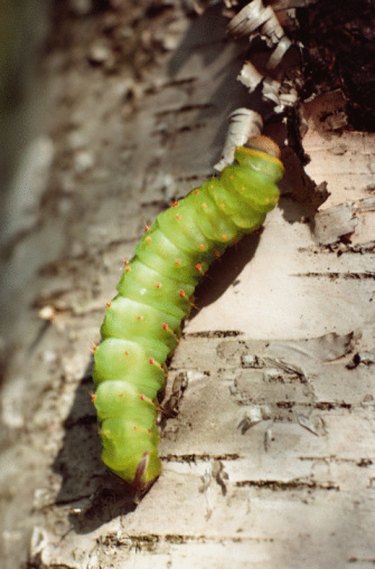
Before they turn into moths and butterflies, such insects must pass through the caterpillar stage, also known as the larval stage. While many caterpillars are harmless, others can cause great damage to trees when large numbers of them eat the leaves. Millions of dollars worth of trees and their lumber are destroyed by these caterpillar species, and the Pennsylvania government spends money on their eradication. By eating leaves, however, some caterpillars stimulate plants to sprout healthier leaves.
Gypsy Moth Caterpillars
Video of the Day
The destructive gypsy moth, Lymantria dispar, consumes millions of acres of trees' leaves each year. Deciduous trees generally die within one year of defoliation, although conifers may succumb more quickly. Gypsy moth caterpillars have five pairs of blue spots on their dorsal surface followed by six pairs of red spots. A thin yellow stripe lines their back. Young gypsy moth caterpillars feed continuously, while older caterpillars, avoiding dry-out and predators, feed only at night. Only the older caterpillars can consume conifers. In Pennsylvania, pupation of mature caterpillars occurs in early summer, and the gypsy moths emerge roughly two weeks later. Gypsy moths do not feed, and they die within one week after mating and egg-laying. Eggs hatch in early spring the following year in Pennsylvania.
Video of the Day
Saddleback Caterpillar
It's obvious why Acharia stimulea received its nickname, saddleback caterpillar. It boasts a green and white "saddle" on its brown body. This caterpillar has bristles, and it stings. People exposed to its venom may develop rashes. The saddleback caterpillar ranges from New England and the eastern seaboard to the southern states and Midwest. Usually seen in summer, it feeds on trees, shrubs and grasses.
Eastern Tent Caterpillar
The population of the tree-defoliating eastern tent caterpillar, Malacosoma americanum (Fabricius), peaks about every decade in late spring or early summer. They primarily feed on apple trees, crab-apple trees and wild cherry trees but also eat other ornamental and deciduous trees. The young larvae is black, but as it ages becomes hairy with brown, white and yellow stripes and blue stripes on its sides. When the moths emerge from their white cocoons, they are red with white stripes on the front of the wings. Young eastern tent caterpillars are easily identified by the web, or tent, they spin in the branches of host trees, where they feed on the leaves for six to eight weeks. The caterpillars leave the tent during daylight hours to feed and return to it in evening. In Pennsylvania, one generation of eastern tent caterpillars is produced annually.
- Pennsylvania Department of Conservation and Natural Resources: What is the Gypsy Moth?
- InsectIdentification.org: Details of the Saddleback Caterpillar
- Pennsylvania State University: Woody Ornamental Integrated Pest Management: Eastern Tent Caterpillar Fact Sheet
- Mothman.org: Adult and Larva of Moths of Pennsylvania; John D. Laskowski